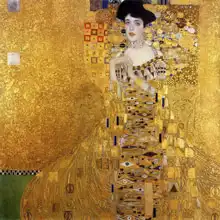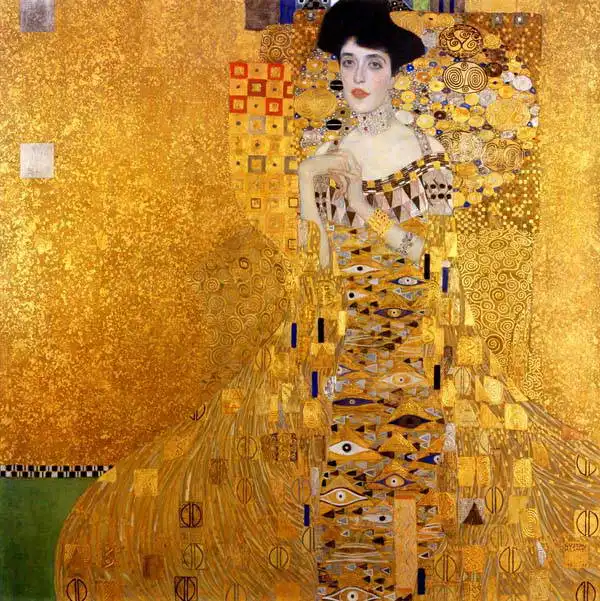Portrét Adele Bloch Bauer I
Rok vzniku:
1907Provedení:
olej na plátněOriginál uložen:
Neue Galerie New YorkRozměr originálu:
138 x 138 cmPortrét Adele Bloch-Bauer, nazývaný také jako Dáma ve zlatém je významné dílo
Gustava Klimta. Tento portrét je dominantou Klimtova zlatého období a vídeňské
secese. Ke zhotovení tohoto díla můžeme taktéž poděkovat Česko-rakouskému bankéři a cukrovarníku židovského původu Ferdinandovi Blochu-Bauerovi, který si nechal roku 1903 tento portrét své manželky Adely Blochové - Bauerové u Klimta objednat.
Portrét je tvořen olejomalbou na plátně a je doplněn
zlatem a stříbrem. Inspirace k třpytivé dekoraci portrétu pevným materiálem vzešla u Klimta v roce 1903, kdy navštívil s malířem a sochařem Maxmilianem Lenzem antickou baziliku San Vitale v Ravenně. Zde jej podle Lenze uchvátilo dílo byzantského umění, raně křesťanská zlatá mozaika císaře Justiniána I. a jeho ženy císařovny Theodory I.
Bohaté používání zlata na úkor barev. Toto spojení s historií vytváří jedinečnou auru, která odlišuje vídeňskou secesi od ostatních verzí secese po celé Evropě. Jemné detaily obličeje Adele Bloch-Bauerové zároveň brání subjektu zmizet v anonymitě vyvolané univerzálním rozsahem malby. Na portrétu si můžeme také povšimnout úchvatného náhrdelníku, který po Adele získala její dcera Maria Altmannová jako svatební dar, avšak nacisté jí ho v období druhé světové války odcizili. Portrét se dnes nachází v newyorské galerii Neue Galerie NY, kde je obdivován tisíci návštěvníky.
Klimt namaloval obraz Portrét Adele Bloch Bauer I v roce 1907. Převládající barvy tohoto obrazu jsou do žluta a jeho formát je Čtverec. Rozměr originálu je 138 x 138 cm. Umístěním originálu obrazu je Neue Galerie New York. Reprodukci tohoto obrazu tiskneme na přání - můžete si zvolit rozměr i provedení reprodukce.
Gustav Klimt (1862 – 1918). Klimt jako malíř reprezentuje nejlepší období Vídně – dobu, kdy tu vznikala díla Sigmunda Freuda či Mahlera a Vídeň byla přinejmenším středoevropským centrem kultury a vzdělání. Klimtovo dílo je kombinací
symbolismu a byzantských rysů, které vytvářejí podtón jeho secesnímu stylu. Klimtovy obrazy mají zvláštní, až úzkostnou atmosféru, často zobrazují freudovskou myšlenku o erotice přítomné v každém lidském pohybu a konání. Maluje dvourozměrně, intenzivními barvami a přitom velice jemně a s vytříbenou důstojností. Mezi Klimtova slavná díla patří
Vodní hadi – dvě ženy se stylizovanými, vzájemně propletenými těly evokujícími neskutečný svět smyslnosti a fantazie. Dále je to
Danaé, dílo inspirované řeckou mytologií zobrazující dívku, které se zmocnil Zeus proměněný ve zlatý déšť (Danaé poté porodila Persea). Jeho obrazy často vzbuzovaly vášně a protesty veřejnosti, a to nejen pro svůj obsah, ale také pro své inovativní malířské postupy – např.
Přítelkyně, obraz dvou žen při milostné schůzce.


























